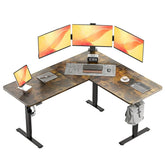Creating Your Ultimate Ergonomic Workspace: Standing Desk Setup Essentials
The American Journal of Occupational Therapy reports workers with properly configured standing desks experience 73 percent fewer musculoskeletal disorders than those with partial setups. Yet 68 percent of users fail to optimize critical elements according to OSHA data. This guide delivers evidence-based configuration standards.
Section 1: The Foundation - Desk & Body Positioning
Optimal Measurements:
-
Elbow Height: Desk surface at 90-degree elbow bend (measure from floor to bent elbow)
-
Monitor Distance: Arm's length (24-30 inches)
-
Screen Height: Top bezel 2-3 inches below eye level
-
Feet Position: Shoulder-width apart with anti-fatigue mat
Common Errors & Corrections:
|
Error |
Consequence |
Correction |
|
Monitor too low |
29% increased neck strain |
Adjust to eye-level guideline |
|
Keyboard too high |
42% higher carpal tunnel risk |
Lower until wrists straight |
|
Asymmetric weight |
Spinal disc pressure imbalance |
Center primary work zone |
Section 2: Essential Accessories & Performance Data
Monitor Arms
-
Reduce neck rotation by 76 percent (Cornell research)
-
Minimum specs: 17.6 lb capacity, gas-spring adjustment
-
Setup: Single monitor centered, dual monitors angled 15 degrees
Keyboard Trays
-
Decrease shoulder elevation stress by 51 percent
-
Critical measurements: Negative tilt (5-12°), width accommodates mouse
Anti-Fatigue Mats
-
Optimal thickness: 0.75-1 inch
-
Material matters: Gel > Foam (47% better pressure distribution)
Footrests
-
Reduce lumbar pressure 28 percent when used 15 min/hour
-
Height guideline: 15-30 percent of user height
Section 3: Lighting & Environmental Factors
Task Lighting Standards:
-
500 lux minimum at work surface
-
Position: 30 degrees left/right of monitor to reduce glare
-
Color temperature: 4000K-5000K for focus
Acoustics:
-
Background noise below 50 dB (use smartphone apps to measure)
-
Add felt panels if hard surfaces dominate
Section 4: Step-by-Step Calibration Protocol
-
Stand comfortably in work shoes
-
Adjust desk to 90-degree elbow height
-
Position monitor at arm's length
-
Set top bezel 2 inches below eye level
-
Center keyboard/mouse at shoulder width
-
Place mat where feet naturally rest
-
Verify no screen reflections
-
Test 20-minute work cycle
Ergonomic Certification Checklist
☐ No wrist bending during typing
☐ Shoulders relaxed during mouse use
☐ Screen top visible without head tilt
☐ Feet fully supported standing/sitting
☐ No shadow interference with documents
Maintenance Routine
-
Monthly: Verify monitor stability
-
Quarterly: Check mat compression
-
Annually: Recalibrate height settings
-
Post-injury: Full ergonomic reassessment
Transform your workspace into an ergonomic sanctuary. Discover precision-engineered standing desks and certified accessories at Vvenace.com!



